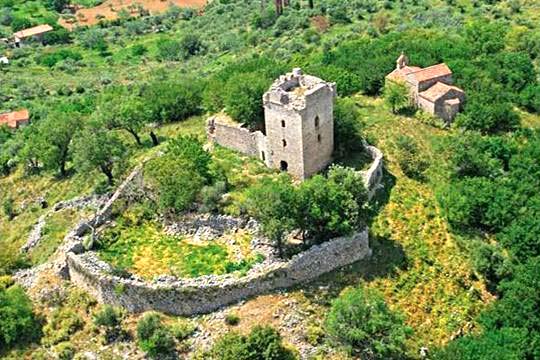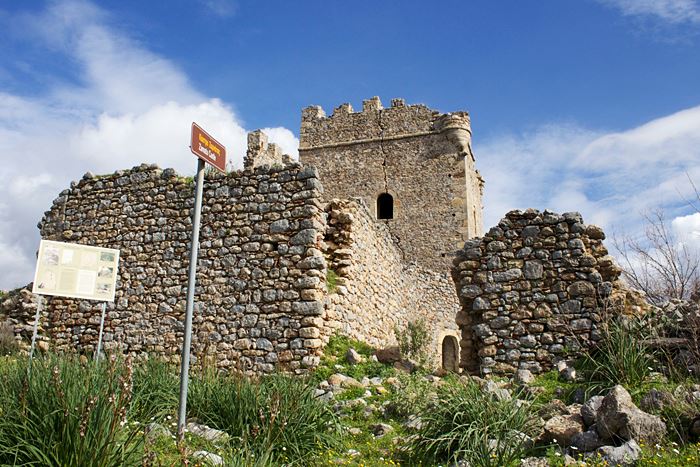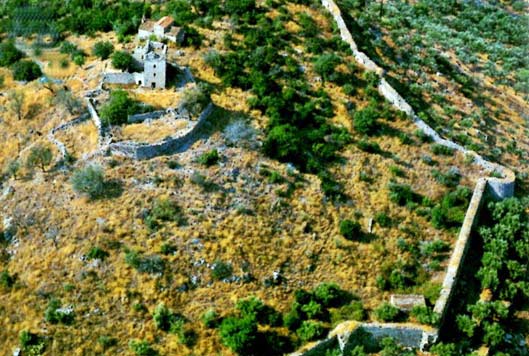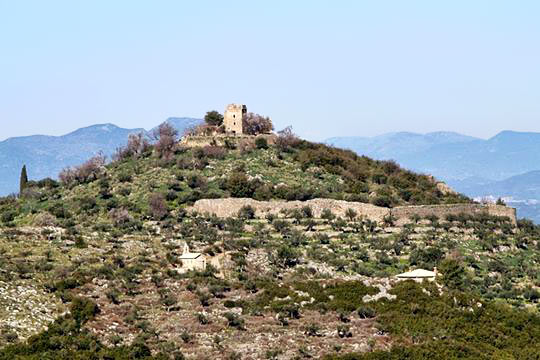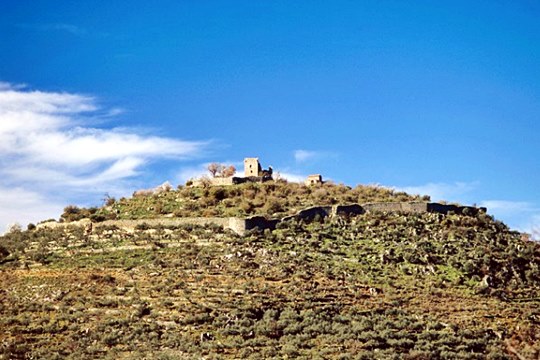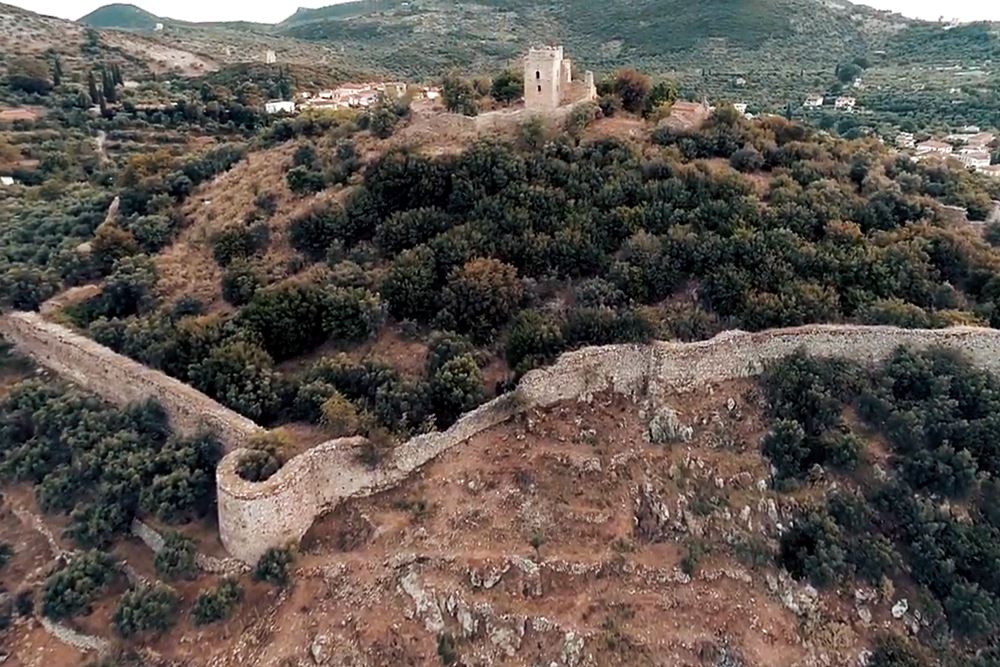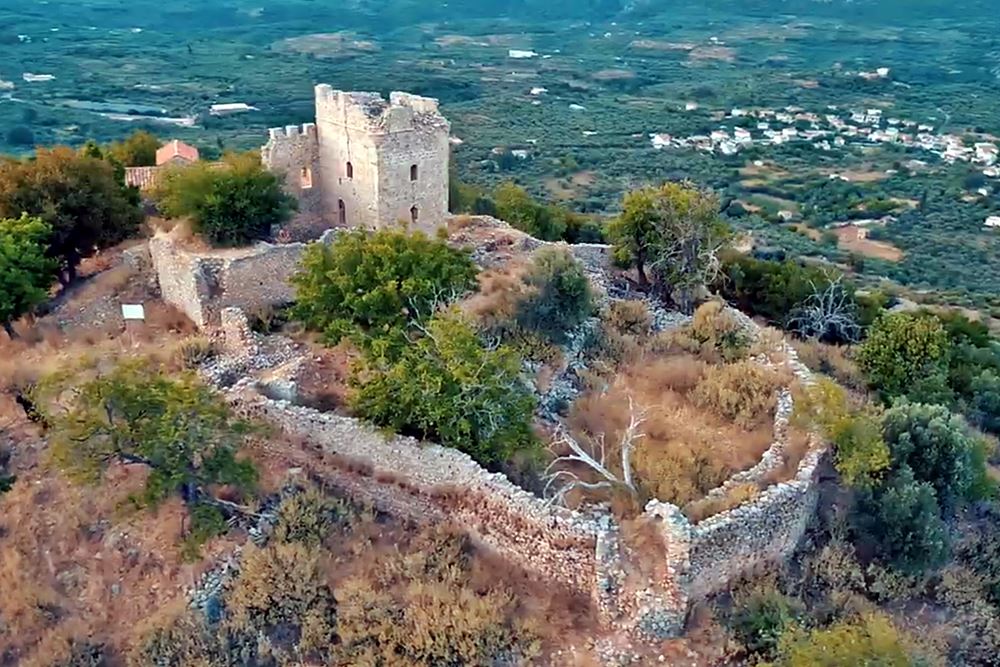Kampos, Dytiki Mani, Messenia,Peloponnese
Castle of Zarnata
| Location: |
| Kampos, Messinia, SW Peloponnese |
| Region > Prefecture: | 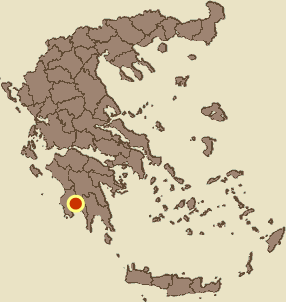 |
| Peloponnese Messenia | |
| Municipality > Town: | |
| City of Dytiki Mani • Kampos | |
| Altitude: | |
|
Elevation ≈ 400 m (Relative Height≈150 m) |
| Time of Construction | Origin | |
| 15th century | Late-BYZANTINE |
|
| Castle Type | Condition | |
| Fortress |
Rather Poor
|
One of the 4 major castles of Mani. It is a castle of the Late-Byzantine period. It had been destroyed by the Ottomans who rebuilt it in the 17th century.
History
In the late Byzantine era, there is a mention of Zarnata being passed from the Despot Theodoros Palaeologos to the eventual last Emperor of Constantinople, Constantine. The walls show a steady development from ancient times and it is thought by some to have Frankish remains but there is no reference to the fortress in Frankish sources - though it seems unlikely that any occupying power would leave such a dominating position vacant.
According to the 17th century Turkish traveller, Evliya Celebi, the fortress was seized by Sultan Mehmet II and his commander Khotsa Mahmud Pasha at about the same time as Corinth and Mistra - in other words around 1460.
Not long later, however, the locals warriors, the Maniates, revolted and took the castle. It is obvious that the Zarnata area changed hands a number of times in the 16th century although it was not in good condition at all during that period.
The castle is known to have been occupied by the the Turks in 1671 just after one of their most serious attempts to subdue Mani. Evliya Celebi accompanied the Turkish troops and gives details of the siege of Zarnata, which he describes as “the key castle of Mani”, by the Ottomans in the spring of 1670. The fortress seems to have surrendered without much of a fight, probably due to the sheer numbers of Ottoman troops which had surrounded Zarnata.
Evliya Celebi was entrusted by the Ottoman general Ali Pasha, with the task of procuring troops and workmen from Albania to rebuild Zarnata from scratch. The defenses were not so much against the threat of the Maniates, who had been soundly crushed in the 1670 campaign, but against the Venetians who still harboured Peloponnesian ambitions. The fort was obviously well repaired and its walls were one 1070 paces in perimeter, were 4 architectural pikhs wide and 12 high (a mason's pikη is 0.75 metres - therefore the walls were 9 metres high and 3 metres wide). The castle had nine strong towers or bastions and Evliya boasted that “It is an unconquerable stronghold”.
In 1685, Morosini, at the head of a Venetian force invaded the Morea laying siege to Koroni on other side of the Gulf of Messenia. When this had fallen, he crossed to Mani where, aided by the Maniates, he laid siege to Zarnata in early September 1685. Although a large Turkish relief force was nearby, Morosini intercepted their messengers and persuaded the Turkish garrison that they had no help at hand. The commander Hasan Pasha surrendered on 11 September and was allowed to withdraw with his troops and sailed away to Elaphonissos island off the easternmost finger of the Peloponnese, Cape Malea. Leake states that at that time, it had a garrison of 600 and bristled with 51 cannon. When he was there in 1805 the place was reputedly in ruins.
The castle fell to the Turks again in 1715 without a fight and it was, with Kelefa in the south, the Turkish bastions which attempted to keep the cork on the Maniate tribes during the late 17th century but doesn't appear to have been inhabited by Turks again. The tower on the top of the hill is a mainly 18th century construction of the local kapetani who became Beys of the Mani. These were the Koutifaris and Koumoundouros families - one of the latter of whom, Alexandros, went on to be a late 19th century Greek Prime Minister.
In 1776 the Turks passed the control of the castle to the Maniates.
The castle played a significant role during the Greek war of Independence.
The castle was last used for its primary purpose as late as the Greek Civil War (1946 - 50) when the inhabitants of the local villages of Stavropigi and Malta moved into the site for safety from the violence between the communist guerrillas and the Nationalist troops - in some cases pulling down the old stone walls and replacing them with barbed wire defences, the remains of which can be found on the western slopes.
| First entry in Kastrologos: | August 2012 | Last update of info and text: | July 2020 | Last addition of photo/video: | January 2024 |
Sources
- Website mani.org - Κάστρο Ζαρνάτας (Greek only)
- Website zorbas.de (John Chapman) - Zarnata
- photos (2, 4, 5, 8÷25) by Yorgos Costopoulos, 2020
- Video by the user nikos.tsiak Κάστρο Ζαρνάτας - Σταυροπήγιο - Μάλτα
- Video by the user G Traveller Κάστρο της Ζαρνάτας | Castle of Zarnata (January 2024)
|
|
| Access |
|---|
| Approach to the monument: |
| On the NR from Kardamylli to Kalamata there are signs leading to the castle at two different points. |
| Entrance: |
| Free entrance |
| Timeline |
|---|
|



